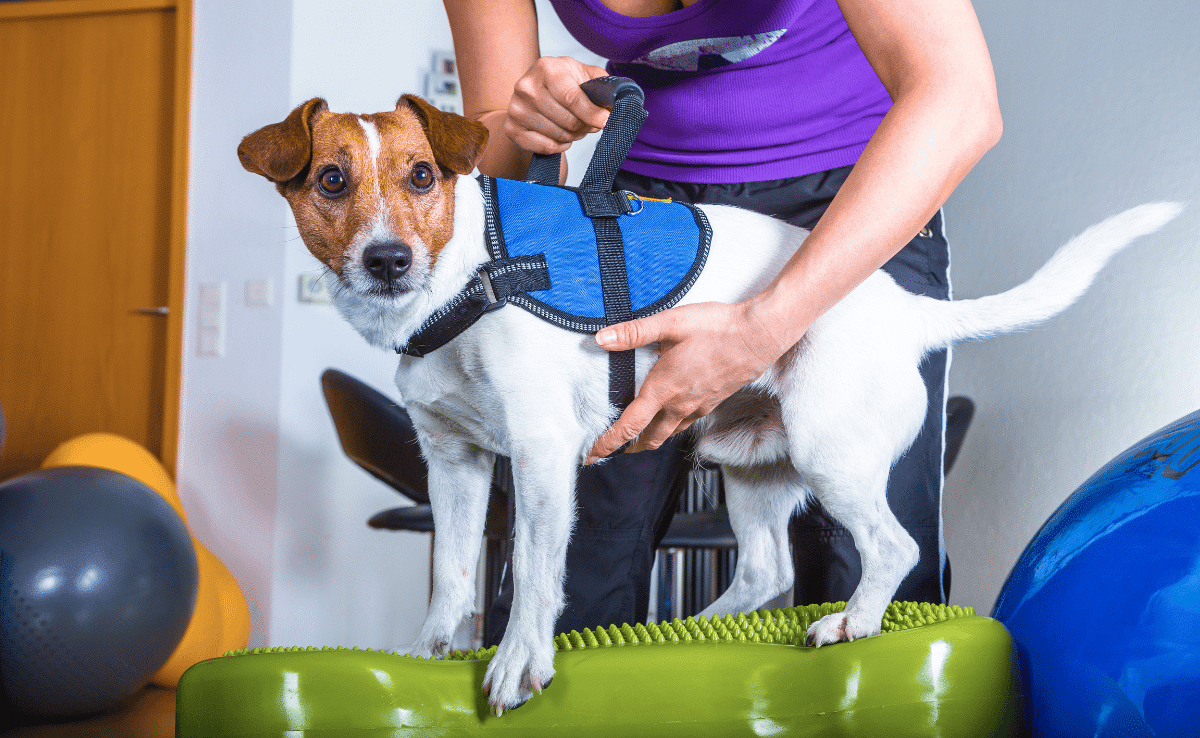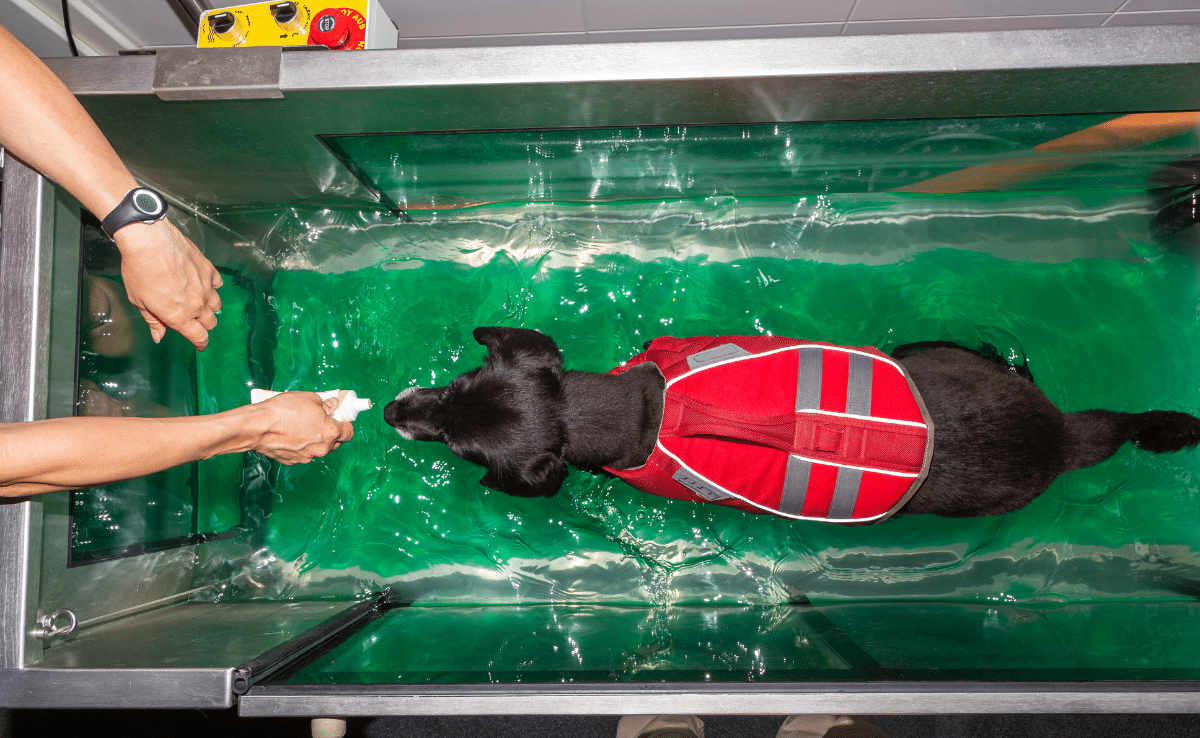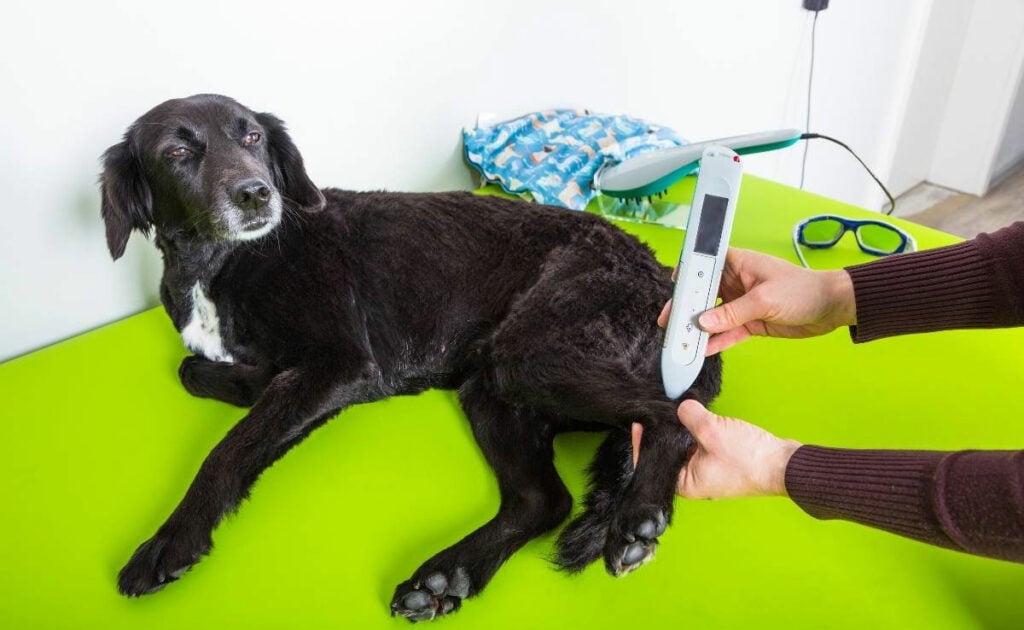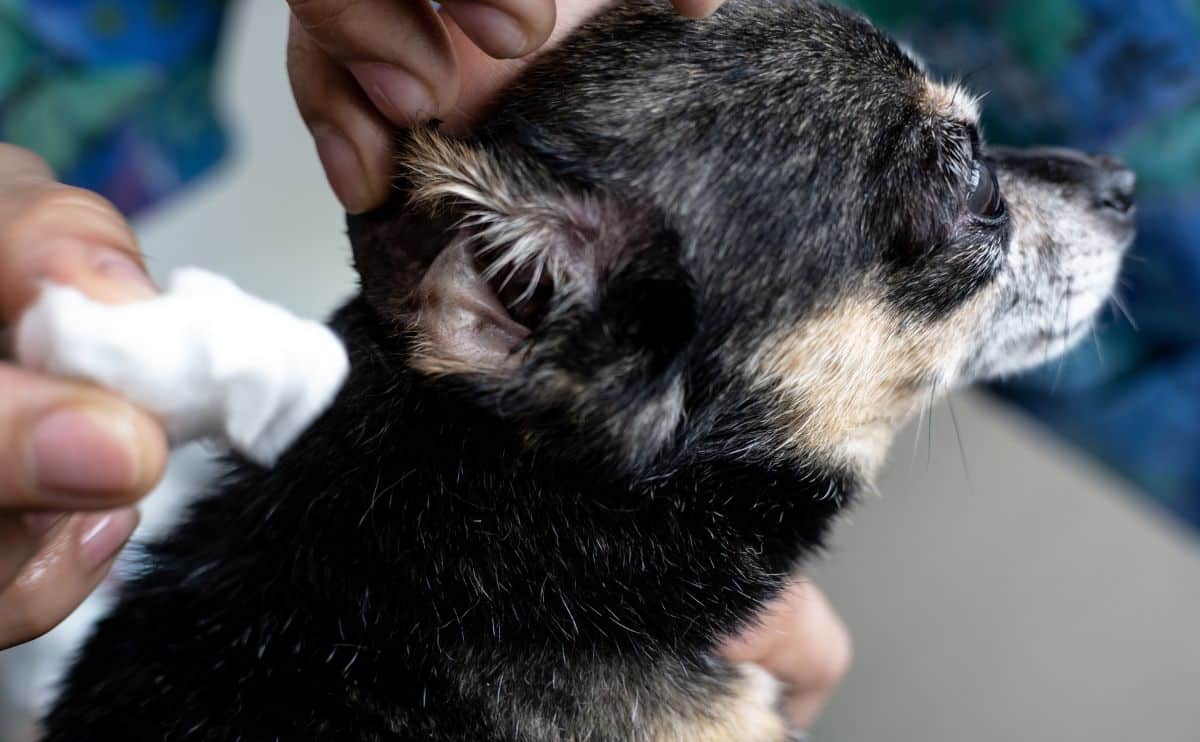Physical Therapy For Dogs? Yes, It’s A Thing, And It Can Work Wonders
When you purchase through links on our site, we may earn a commission. Here’s how it works.
Is your dog limping, slowing down, or struggling after surgery? You don’t have to “wait and see.”
Table of Contents
Physical therapy for dogs is one of the fastest-growing forms of veterinary care. From laser therapy and underwater treadmills to massage and stretching routines, canine rehab helps injured, arthritic, or aging dogs recover mobility, reduce pain, and get back to doing what they love (like zoomies or couch jumps).
Whether your dog is bouncing back from surgery or just not bouncing like they used to, rehab might be the missing piece in their care plan.
What Is Physical Therapy for Dogs (And Who’s Actually Qualified to Do It?)
Physical therapy for dogs—also called canine rehabilitation—is more than a trend or luxury treatment. It’s an evidence-based approach to improving your dog’s mobility, reducing pain, and helping them recover from surgery, injury, or chronic conditions.

But here’s something most pet owners don’t know:
In most states, the term “physical therapist” is legally reserved for human medicine.
That’s why your dog’s rehab provider will be called a canine rehabilitation therapist or veterinary rehabilitation professional—but they’re highly trained and often medically licensed.
Who Can Become A Canine Rehab Therapist?
The people qualified to perform canine rehab must already have a medical background. That includes:
- Veterinarians
- Licensed veterinary technicians
- Human physical therapists and PT assistants
- Occupational therapists
These professionals can pursue specialized training and certification in canine rehab—and it’s not just a weekend workshop.
Where Do They Train?
Only a few accredited programs exist in the U.S., and they require extensive academic and clinical work. Some of the most respected programs include:
- University of Tennessee: Offers the Canine Rehabilitation Certificate Program (CCRP)
- Canine Rehabilitation Institute (CRI): Offers certifications such as Canine Rehabilitation Therapist (CCRT) and Canine Rehabilitation Veterinary Nurse (CCRVN)
- Chi University: Offers the Certified Veterinary Medical Manipulation Practitioner (CVMMP) program, focusing on spinal and musculoskeletal therapies
Veterinarians can also pursue advanced specialization through the American College of Veterinary Sports Medicine and Rehabilitation (ACVSMR) to become a board-certified diplomate in this field.
How To Know If Your Dog’s Therapist Is Legit
Certified rehab professionals often include their credentials after their names (like “CCRP,” “CCRT,” or “CVMMP”). Look for these on clinic websites or ask directly—you should always confirm certification before starting a rehab plan.
Pro tip: If someone is offering canine rehab without these credentials, it’s a red flag. You want a certified expert working with your pup’s joints, spine, and nerves.
Who Needs Physical Therapy? (Hint: It’s Not Just Injured Dogs)
Canine rehab isn’t just for dogs recovering from surgery or training for agility competitions. Many everyday dogs benefit from physical therapy, often in ways their owners didn’t expect.

Here’s who might need it—and what signs to watch for.
Slowing Down With Age
- If your senior dog is stiff, hesitant to jump, or struggles to get up after naps, that’s not just “getting old”—it could be a sign of arthritis or joint pain.
- Rehab helps maintain muscle strength, reduce inflammation, and improve quality of life well into the golden years.
Healing From Surgery or Injury
- Dogs recovering from orthopedic surgery (ACL/CCL repair, hip replacement, etc.) often heal faster and move better with rehab.
- Rehab can also support non-surgical treatment for sprains, strains, or spinal issues.
Managing Chronic Conditions
- Hip dysplasia, luxating patella, intervertebral disc disease (IVDD), degenerative myelopathy—these aren’t curable, but physical therapy can slow progression and reduce pain.
- Rehab may help preserve function, especially in the early stages.
Struggling With Weight Or Mobility
- Obese dogs put more stress on their joints and spine. Physical therapy can help them safely get moving again—without putting them at risk for injury.
- Water therapy (hydrotherapy) is a favorite for these pups: low-impact, high-results.
Dealing With Neurological Issues or Paralysis
- Dogs with nerve damage, strokes, or partial paralysis often regain more function than expected through targeted rehab—sometimes even learning how to walk again.
Dogs Showing Subtle Behavioral Changes
You don’t need a diagnosis to notice something’s off. These small shifts can be early signs of pain or mobility issues:
- Limping or bunny hopping
- Slipping on floors
- Avoiding furniture they used to jump on
- Not wanting to play or walk as long as they used to
If you’ve ever searched “Why is my dog limping?” this type of support could help before the issue worsens.
What Does Dog Rehab Actually Look Like?
Canine rehab isn’t one-size-fits-all. Therapists often combine techniques to support healing, manage pain, and restore movement—tailored to your dog’s specific condition.
Here are some of the most common therapies used in veterinary rehab and how they can help your pup feel better faster.
Massage Therapy
Massage may sound indulgent, but for dogs in pain, it’s serious medicine.

Therapists use targeted techniques to:
- Reduce tension and inflammation
- Increase circulation
- Improve joint mobility
- Help dogs relax and heal
It’s especially beneficial for senior dogs with arthritis or pups recovering from injury.
Manual Therapy
This includes hands-on techniques like passive range of motion, joint mobilization, and veterinary chiropractic care.
Manual therapy can:
- Ease joint stiffness
- Improve flexibility
- Promote better spinal alignment
- It’s often used alongside massage for dogs with orthopedic or neurological issues
Hydrotherapy
Water therapy, or hydrotherapy, is one of the most popular and effective treatments in canine rehab.

Using an underwater treadmill or controlled swim sessions, hydrotherapy:
- Reduces strain on joints thanks to buoyancy
- Builds strength and endurance with low-impact
- Improves range of motion without overloading healing tissues
It’s ideal for dogs with arthritis, hip dysplasia, or post-surgical recovery.
Therapeutic Exercises
These are customized strength and mobility workouts designed by a rehab therapist. They help with:
- Rebuilding muscle after injury or surgery
- Improving balance and coordination
- Slowing the progression of degenerative conditions

Exercises may include sit-to-stand transitions, weight shifting, obstacle courses, and balance discs. Many can be done at home between sessions.
We explain how to do some of these at-home physical therapy exercises later in the article.
Land Treadmill Training
Unlike hydrotherapy, this uses a standard treadmill—often with support harnesses for stability. It’s used to:
- Re-train walking patterns after a stroke or spinal injury
- Encourage proper limb use post-surgery
- Support general fitness and conditioning
It’s also helpful for dogs with weight-bearing challenges or gait abnormalities.
Electronic Therapies
These non-invasive tools may sound futuristic, but they’re widely used in both human and veterinary physical therapy to:
- Stimulate circulation
- Speed up tissue repair
- Control pain and inflammation
- Prevent muscle loss during recovery

Common types include:
- Laser therapy
- Therapeutic ultrasound
- TENS (transcutaneous electrical nerve stimulation)
- NMES (neuromuscular electrical stimulation)
These tools are often used in combination with other therapies for maximum benefit.
Acupuncture
Veterinary acupuncture involves inserting tiny needles into specific points on the body to stimulate healing.
It can help:
- Relieve chronic pain
- Improve blood flow
- Reduce muscle spasms
- Support dogs with arthritis, neurological issues, or post-operative discomfort
While it may seem surprising, acupuncture is backed by science and is commonly used in integrative veterinary care.
Tip: Most rehab plans combine several therapies based on your dog’s condition, age, and comfort level. Your therapist will guide you through what’s appropriate—and what results to expect.
How Much Does Dog Physical Therapy Cost?
Physical therapy for dogs isn’t just effective—it’s also an investment. Costs vary depending on where you live, the type of therapy used, your dog’s condition, and how many sessions are recommended.
Typical Costs
- Initial consultation: $100 to $200, which includes an evaluation, diagnosis, and a customized treatment plan.
- Follow-up therapy sessions: $50 to $75 per session or more. Some clinics charge by session type or length (30 vs. 60 minutes), while others offer packages or bundles.
- Specialty therapies (like hydrotherapy or laser): May be priced higher depending on the equipment used.
Your dog’s treatment plan might involve just a few sessions or ongoing weekly visits, especially for chronic conditions like arthritis or degenerative myelopathy. Sometimes, your therapist will teach you at-home exercises to supplement sessions and help lower long-term costs.
Tip: Ask about package deals or progress-based reevaluations. Some clinics offer discounts when you book multiple sessions upfront.
Does Pet Insurance Cover It?
Some pet insurance companies cover physical therapy and alternative treatments, but only if the policy is active and passed the waiting periods before your dog is injured or diagnosed.
Coverage varies, but here’s what you should know:
- Rehab coverage may be included or available as an add-on under “alternative or holistic therapies”
- Pre-existing conditions are usually not covered, so the timing of enrollment matters
- Therapist credentials often matter, so check if your provider requires a licensed vet or certified rehab professional
If you already have pet insurance, review your plan or call your provider to confirm what’s included. Enrolling while your dog is healthy can protect you from high out-of-pocket costs.
View our picks for best pet insurance, including pros, cons, and personal experience.
How To Choose The Right Rehab Therapist For Your Dog
Once you realize your dog could benefit from physical therapy, finding a qualified professional you trust is the next step. However, not every facility advertising “dog rehab” is staffed by certified experts, and not every dog needs the same treatment.
Here’s how to make sure your pup is in the right hands.
1. Look For Proper Credentials
Certified canine rehab professionals are trained in dog-specific anatomy, movement science, and therapeutic techniques. The most common certifications you’ll see include:
- CCRP (Certified Canine Rehabilitation Practitioner)
- CCRT (Certified Canine Rehabilitation Therapist)
- CCRVN (Certified Canine Rehabilitation Veterinary Nurse)
These credentials signal advanced, hands-on training from programs like the University of Tennessee or the Canine Rehabilitation Institute. Providers often list these after their name on clinic websites, business cards, or appointment paperwork.
Tip: Don’t just assume anyone offering “rehab” is certified. Always check the provider’s credentials before starting treatment.
2. Ask The Right Questions
Not sure what to ask on that first call or consultation? Start with these:
- What certifications does your rehab team hold?
- Will you coordinate with my primary veterinarian?
- How do you personalize treatment plans for each dog?
- Can I watch or be involved in sessions?
- Will you teach me exercises to do at home?
- Have you treated dogs with this condition before?
You’re not being picky—you’re being thorough. A reputable clinic should welcome your questions and explain their process clearly.
3. Use A Trusted Directory
Want to search for a certified therapist near you? These directories can help:
- Canine Rehabilitation Institute – Find a Therapist
- American Association of Rehabilitation Veterinarians
- Your veterinarian may already partner with a local specialist
Virtual consultations and hybrid treatment plans (with at-home exercises) may be available to supplement in-person sessions if you live in a smaller town or remote location.
4. Watch For Red Flags
A provider should be trained, transparent, and focused on safety. Be cautious of any clinic that:
- Doesn’t clearly list staff credentials or training background
- Offers rehab without veterinary oversight or input
- Refuses to customize treatment plans
- Avoids discussing progress tracking or re-evaluations
If something feels off, trust your instincts—and get a second opinion.
At-Home Physical Therapy Exercises For Your Dog
While professional canine rehabilitation offers specialized care, incorporating at-home exercises can significantly enhance your dog’s recovery and overall well-being.
Always consult your veterinarian or a certified canine rehabilitation therapist before starting any new exercise regimen to ensure it’s appropriate for your dog’s specific condition.
1. Sit-To-Stand Transitions
Purpose: Strengthens hind limbs and improves joint flexibility.
How to Do It:
- Encourage your dog to sit, then stand, using a treat or verbal cue.
- Repeat this motion 5–10 times, ensuring controlled movements.
- Perform 2–3 sets daily, based on your dog’s tolerance.
Tip: Ensure your dog maintains proper form to avoid strain.
Watch: How To Safely Do Sit-To-Stand Exercises With Your Dog
Sit-to-stand transitions are one of the simplest and most effective at-home exercises for improving your dog’s strength, stability, and joint health. In this short video, a certified canine rehab therapist demonstrates proper technique, posture cues, and how to ensure your dog moves safely through each rep.
2. Controlled Leash Walking
Purpose: Enhances balance, coordination, and endurance.
How to Do It:
- Use a short leash to guide your dog at a steady pace.
- Incorporate changes in direction and gentle inclines if possible.
- Keep sessions short initially, gradually increasing duration.
Tip: Avoid slippery surfaces to prevent falls.
Watch: Controlled Leash Walking For Post-Surgery & Injury Recovery
Controlled leash walking is a foundational exercise in canine rehabilitation, particularly beneficial for dogs recovering from surgery or injury.
This video demonstrates techniques to help your dog regain strength, improve gait, and rebuild confidence through slow, deliberate walks. It’s an essential part of a structured recovery plan and can be adapted to your dog’s specific needs.
3. Weight Shifting
Purpose: Improves balance and proprioception.
How to Do It:
- While your dog stands, gently shift their weight from side to side.
- Hold each position for a few seconds before returning to center.
- Repeat 10 times per session.
Tip: Support your dog as needed to ensure safety.
Watch: Guided Weight Shifting For Balance & Joint Support
Weight shifting is a gentle, hands-on exercise that helps dogs improve balance, body awareness, and joint stability—especially after injury or surgery. In this video, you’ll see how a rehab professional uses subtle movements to guide a dog through safe, effective weight distribution exercises.
4. Backward Walking
Purpose: Strengthens hindquarters and enhances coordination.
How to Do It:
- Encourage your dog to take a few steps backward using a treat or cue.
- Start with 2–3 steps, gradually increasing as your dog becomes more comfortable.
- Perform five repetitions per session.
Tip: Use a hallway or narrow space to guide straight movement.
Watch: Teaching Backward Walking To Improve Hind-End Strength
Backward walking is a targeted rehab exercise that helps build strength in your dog’s hind limbs, improve coordination, and support joint stability. In this video, you’ll see how to safely guide your dog through a few backward steps using treats and gentle cues.
5. Cavaletti Poles
Purpose: Increases limb awareness and flexibility.
How to Do It:
- Set up a series of low poles or obstacles spaced evenly apart.
- Lead your dog over the poles at a slow, controlled pace.
- Begin with 5–6 poles, adjusting height and spacing as needed.
Tip: Ensure poles are stable to prevent slipping.
Watch: Cavaletti Pole Progressions For Flexibility & Limb Awareness
Cavaletti training involves walking your dog over a series of spaced poles to improve coordination, flexibility, and joint mobility. In this video, you’ll see how a rehab therapist gradually increases difficulty by adjusting pole height and spacing—allowing dogs to progress at their own pace.
6. Balance Exercises
Purpose: Enhances core strength and stability.
How to Do It:
- Use a balance disc or wobble board designed for canine use.
- Encourage your dog to place front paws on the device, maintaining position for 5–10 seconds.
- Gradually increase duration and complexity as your dog progresses.
Tip: Always supervise your dog during balance exercises to prevent falls.
Watch: Balance Exercises To Strengthen Core Muscles & Stability
Balance work helps dogs develop core strength, coordination, and confidence—especially those recovering from injury or managing age-related mobility loss. In this video, you’ll learn how to use a balance disc to safely engage your dog’s muscles and improve overall stability.
Frequently Asked Questions
We’ve answered some of the most common questions about canine physical therapy, from arthritis to IVDD to stroke recovery. Don’t see your question here? Ask us in the comments!
Is Physical Therapy For Dogs With Arthritis Worth It?
Yes. For dogs with arthritis, physical therapy can reduce stiffness, improve joint function, and ease pain without relying solely on medications. It can also slow the progression of arthritis by strengthening surrounding muscles and improving mobility.
What’s The Best Luxating Patella Physical Therapy For Dogs?
A customized plan typically includes strengthening exercises for the quadriceps, controlled walking, and balance drills. Therapy can improve knee stability and delay or even avoid the need for surgery in mild cases.
Is Physical Therapy For IVDD Effective?
It can be very effective, especially when started early. Dogs with IVDD often benefit from a combination of laser therapy, controlled movement exercises, and sometimes hydrotherapy to regain strength and coordination.
Does Physical Therapy For Paralyzed Dogs Work?
In many cases, yes. While not all dogs regain full function, physical therapy can help preserve muscle tone, reduce secondary complications, and, in some cases, restore partial mobility. It’s often recommended as part of a long-term recovery plan.
What Are The Best Physical Therapy Exercises For Dogs With Hip Dysplasia?
Common rehab options include sit-to-stand transitions, underwater treadmill sessions, and range-of-motion exercises. These help strengthen the muscles around the hip joint and reduce compensatory strain on other parts of the body.
What Are The Best Physical Therapy Exercises For Dogs With Degenerative Myelopathy?
While degenerative myelopathy is progressive, physical therapy can help maintain function and comfort for as long as possible. Exercises often include assisted walking, balance work, and coordination drills. Swimming or underwater treadmill sessions are also helpful.
Does Canine Rehab Help Dogs Recover From A Stroke?
Yes. Rehab focuses on retraining the nervous system, improving coordination, and helping dogs regain strength. Recovery depends on severity of the stroke, but early intervention often leads to better outcomes.
How Can I Help Relieve My Dog’s Pain?
We all hate to see our dogs suffer from pain and want to help them as much as possible. Fortunately, you have some all-natural options that can help with pain management in dogs recovering from an injury or surgery and those with chronic conditions.
CBD for dogs may help ease pain and reduce anxiety. Dog joint supplements can be very effective in relieving pain and inflammation and improving joint health in pups with arthritis and other orthopedic problems. Just be sure to consult your veterinarian before giving your dog any supplements.



